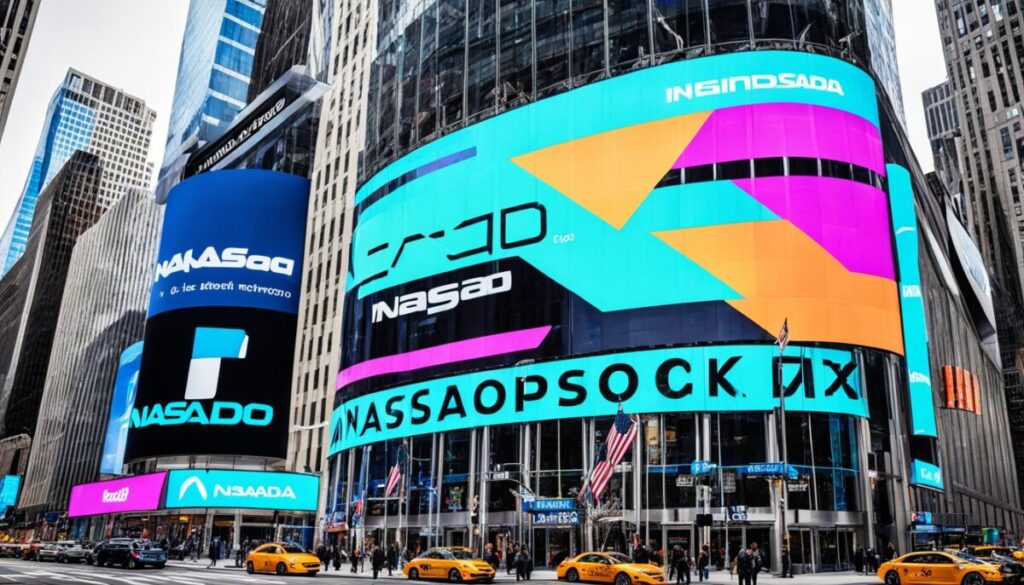The Nasdaq Composite Index is a key market index that tracks over 2,500 stocks on the Nasdaq exchange. It’s heavily influenced by the tech sector, making up 55% of its value. This index reflects the tech industry’s strong role in the economy.
The top 10 companies in the Nasdaq Composite Index are huge, making up about 50% of its value. This shows how big the tech industry is in this benchmark.

Key Takeaways
- The Nasdaq Composite Index is a highly diversified index that tracks over 2,500 stocks listed on the Nasdaq exchange.
- Technology stocks make up the majority of the index’s value, reflecting the industry’s outsized influence in the market.
- The top 10 companies in the Nasdaq Composite account for a significant portion of the index’s total market capitalization.
- Over the past decade, the Nasdaq Composite has outperformed the S&P 500 in seven out of ten years.
- Investing in the Nasdaq Composite can be done through index mutual funds and ETFs, providing exposure to the tech-heavy benchmark.
Introduction to the Nasdaq Index
The Nasdaq was created in 1971 as the world’s first electronic stock market. It started as a system for trading Over-The-Counter (OTC) stocks efficiently. By the 1980s, it became a key place for technology companies to raise money, helping the tech sector grow.
Overview of the Nasdaq Stock Exchange
Now, the Nasdaq is the second-biggest stock market in the world by value. It has over 4,061 listings as of February 2024. The total value of these listings is US$23.414 trillion, showing its big role in the financial world.
Since starting, Nasdaq has grown from a simple quotation system to a bustling market. It trades almost half of the U.S. securities markets’ total shares.
Significance of the Nasdaq Composite Index
The Nasdaq Composite Index is the top index watched around the world. It’s often seen as a measure of the tech sector’s health. This index shows how well technology and growth companies are doing.
The index hit a high of 5,132.52 on March 10, 2000, during the dot-com boom. Then, it fell 78% to 3,227 by April 17, 2002, during the bust.
“The Nasdaq Composite Index is a key indicator of the performance of technology and growth companies, reflecting the continuously evolving global financial landscape.”
NASDAQ index Composition and Methodology
The Nasdaq Composite Index tracks over 2,500 stocks on the Nasdaq exchange. To join, a stock must be listed only on Nasdaq and be a common stock. American depositary receipts (ADRs), real estate investment trusts (REITs), and limited partnership shares can also join.
Eligibility Criteria for Inclusion
The Nasdaq Composite Index regularly checks its members. Stocks that don’t meet the rules can be removed. The main rules for joining the index are:
- Listed only on the Nasdaq market
- Must be a common stock of one company
- Can be common stocks, tracking stocks, or ADRs
- Must have an average daily traded value of at least $5 million (USD) for three months
- Must have a free float of at least 10%
- Companies in bankruptcy or not eligible won’t be included
Weighting and Calculation Methods
The Nasdaq Composite Index uses a market capitalization method. It adds up the market value of its stocks based on their current price. This means big companies have a bigger effect on the index than small ones.
The index is updated all day, with its value shared once a second from 9:30 a.m. to 5:16 p.m. ET.
| Nasdaq Composite Index Sector Breakdown (as of July 10, 2023) | Percentage |
|---|---|
| Technology | 55.32% |
| Consumer Discretionary | 18.80% |
| Healthcare | 8.08% |
| Industrials | 4.66% |
| Financials | 3.47% |
| Telecommunications | 3.22% |
| Consumer Staples | 2.96% |
| Energy | 1.05% |
| Real Estate | 1.05% |
| Utilities | 0.94% |
| Basic Materials | 0.45% |
The Nasdaq Composite Index focuses on market size, with the top 10 companies making up over 40% of its value as of March 31, 2023. It changes every year, picking companies by their market size.
Nasdaq Index: A Tech-Driven Powerhouse
The Nasdaq Composite Index shows the tech focus of the Nasdaq exchange. It’s mostly made up of technology companies. This index tracks the performance of tech giants and startups, showing the tech industry’s big impact on finance.
Technology companies make up over 62% of the index. Other sectors like consumer services, health care, and industrials also play big roles. But, technology leads the way in driving the index’s growth.
The Nasdaq 100 Index is a key part of the Nasdaq Composite. It tracks the top 100 companies on the Nasdaq. About six out of ten of these companies are in tech, showing the index’s strong tech focus.
The Nasdaq Composite Index uses market size to set weights. So, big tech companies have more power. For example, Microsoft, Apple, and Nvidia make up 17.2% of the S&P 500’s weight. This shows how these tech giants affect the Nasdaq Composite.
The Nasdaq is the second-largest stock exchange globally by market size. It’s not just about tech. It has companies from many sectors, showing its wide impact on finance.

“The Nasdaq Composite Index is more influential than the Nasdaq 100, and it serves as a widely followed barometer of the technology sector’s financial health.”
The tech industry keeps growing and changing the world economy. So, the Nasdaq Composite Index will keep being a key indicator for investors and analysts.
Key Players in the Nasdaq Index
The Nasdaq Composite Index is led by some of the biggest and most powerful tech companies globally. By March 31, 2023, the top 10 securities in the index were Apple (13.79%), Microsoft (11.44%), Amazon (6.04%), NVIDIA (4.72%), Tesla (3.75%), Alphabet Class A (3.21%), Alphabet Class C (3.21%), Meta Platforms (2.87%), Broadcom (1.63%), and PepsiCo (1.15%). These tech giants and other top companies greatly affect the Nasdaq Composite Index’s performance.
Sector Breakdown
The Nasdaq Composite Index’s sector breakdown as of July 10, 2023 was as follows:
- Technology (55.32%)
- Consumer Discretionary (18.80%)
- Healthcare (8.08%)
- Industrials (4.66%)
- Financials (3.47%)
- Telecommunications (3.22%)
- Consumer Staples (2.96%)
- Energy (1.05%)
- Real Estate (1.05%)
- Utilities (0.94%)
The index focuses mainly on the technology sector. Yet, it also touches on other key industries. This shows the diverse nature of companies listed on the Nasdaq.

Historical Performance and Market Trends
The Nasdaq Composite Index has seen ups and downs over the years. It reflects the changing tech-driven economy it tracks. In the late 1990s, it grew fast, thanks to the internet boom. But, the dot-com bubble burst in the early 2000s, causing a big drop and a lot of uncertainty.
Despite the ups and downs, the Nasdaq Composite has shown strength and flexibility. It has grown beyond tech to include biotech, finance, and industrial companies. This move has helped it stay strong through market changes, keeping it a key indicator of the tech economy.
Dotcom Boom and Bust
The late 1990s saw the Nasdaq Composite soar, reaching a high of 5,048.62 on March 10, 2000. This was due to the excitement around internet companies, even if their business plans were unclear.
But, the bubble burst, and the Nasdaq fell by over 78% by October 2002, hitting 1,114.11. This period was tough for the markets, leading to a wider economic slowdown. It made people focus more on financial stability and sustainable business.
Recent Volatility and Market Movements
Recently, the Nasdaq Composite has seen a lot of ups and downs. In the first quarter of 2022, it dropped by 9.1%, its biggest fall since 2020. April 2022 was even worse, with a 12% drop, its largest since 2008.
These changes show how important the Nasdaq is for tracking the tech economy. Things like inflation, interest rates, and global tensions have made the market volatile. Investors need to watch the Nasdaq closely to understand its impact on the wider market.
“The Nasdaq Composite Index has demonstrated remarkable resilience and adaptability, diversifying its listings and expanding beyond the technology sector to include biotechnology, financial, and industrial companies.”
Investing in the Nasdaq Index
For those looking to tap into the Nasdaq Composite Index’s growth, index funds and exchange-traded funds (ETFs) are great choices. They mirror the Nasdaq Composite’s performance. This makes them a simple way to invest in tech and other sectors in the index.
Index Funds and ETFs
The Fidelity Nasdaq Composite Index Fund tracks the Nasdaq Composite Index closely. The Invesco QQQ ETF focuses on the Nasdaq-100 Index. This includes the 100 largest non-financial companies on the Nasdaq exchange.
These funds and ETFs have many benefits for investors:
- They spread out investments across the Nasdaq index’s companies.
- They have low fees, often under 0.3%.
- They follow the Nasdaq without the need to pick individual stocks.
- They could grow in value over time by tracking the Nasdaq’s performance.
Remember, investing in the Nasdaq through index funds and ETFs means your returns will depend on the Nasdaq’s overall performance. This includes its ups and downs.
“For the majority of Americans, the best thing to do is to own the S&P 500 index fund and hold it forever.”
– Warren Buffett, renowned investor
The Nasdaq exchange is known for its tech focus and innovation. It has done well over the years. Investing in index funds and ETFs tracking Nasdaq gives investors a chance to be part of this growth.
Conclusion
The Nasdaq Composite Index is key to tracking the tech sector and the overall market’s health. It focuses on leading tech companies, both new and well-known. This makes it a key benchmark for investors wanting to tap into the tech industry’s growth.
This index has seen ups and downs, showing how the global financial scene changes. It’s shown its strength and ability to adapt to these changes.
For those wanting to invest in the tech economy, the Nasdaq Composite Index and related funds offer a way to do so. These options let investors easily get into the tech sector’s growth. The index is important for understanding the tech-heavy market’s trends.
The tech sector keeps evolving and shaping the global economy. The Nasdaq Composite Index will keep being crucial for investors, analysts, and policymakers. It gives insights into the tech sector’s performance and investment chances in this fast-changing market.
FAQ
What is the Nasdaq Composite Index?
The Nasdaq Composite Index is a big index that tracks over 2,500 stocks on the Nasdaq exchange. It focuses a lot on the tech sector.
What is the history of the Nasdaq stock exchange?
The Nasdaq started in 1971 as the first electronic stock market. It was a big change for trading Over-The-Counter (OTC) stocks. By the 1980s, it became key for tech companies to raise money, helping the tech sector grow.
What is the significance of the Nasdaq Composite Index?
The Nasdaq Composite Index is the top index watched worldwide. It’s seen as a key indicator of tech and growth company performance. It shows how the global financial scene is always changing.
What are the eligibility criteria for inclusion in the Nasdaq Composite Index?
To be in the Nasdaq Composite Index, a stock must trade on the Nasdaq exclusively. It can be a common stock, an American depositary receipt (ADR), a real estate investment trust (REIT), or a limited partnership share.
How is the Nasdaq Composite Index calculated?
The Nasdaq Composite Index uses a market cap method to calculate its value. It adds up the market caps of its stocks based on current prices. This means big companies have a bigger impact on the index.
What is the sector breakdown of the Nasdaq Composite Index?
The Nasdaq Composite Index is mostly about the tech sector. This reflects the innovative nature of Nasdaq companies. As of July 10, 2023, the sectors were: Technology (55.32%), Consumer Discretionary (18.80%), Healthcare (8.08%), and more.
What are the top-weighted companies in the Nasdaq Composite Index?
The top 10 companies in the index as of March 31, 2023, were Apple, Microsoft, Amazon, NVIDIA, Tesla, and others. These companies make up a big part of the index.
How has the Nasdaq Composite Index performed historically?
The Nasdaq Composite Index grew a lot in the late 1990s with the dot-com boom. But it fell hard in the early 2000s with the dot-com bubble burst. Since then, it has seen a lot of ups and downs, showing how the tech sector reacts to the economy.
How can investors gain exposure to the Nasdaq Composite Index?
Investors can easily get into the Nasdaq Composite Index by buying an index fund. These funds track the index, giving investors broad exposure to tech and other sectors in the index.

1 thought on “Nasdaq Index: Understanding the Tech-Heavy Benchmark”